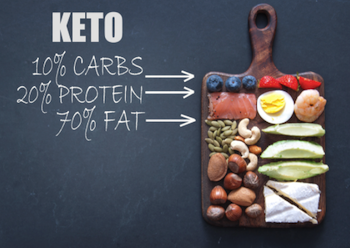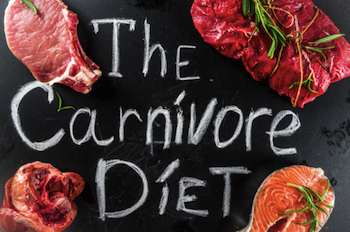
Six Ways to Know If You’re on a Fad Diet
And Why Fad Diets Don’t Work
Have you ever gone on a fad diet (What is a “fad diet” anyway?) Did it work? Do you want to be able to know – at a glance – whether a diet is legit or money-making hype?
Maybe you’re curious about popular types of diets, or have tried multiple diets of all kinds. (I am in both groups – I love learning about new diets and have tried a lot of them myself!)
Whether you’re a veteran dieter or just want to learn more about nutrition, this post will give you the information you need to tell whether a diet is a “fad” or not, plus make an informed decision about whether a particular diet is for you.
New fad diets that promise quick results are so tempting! You see the dramatic before-and-after photos, enthusiastic testimonies from people who have changed their lives for the better, all because of the newest diet trend. Yes, most fad diets can and do deliver weight loss to their devout followers, but the long-term truth is that most people who go on fad diets don’t stay on them forever and regain lost weight (plus more). Why is this?
What’s Wrong With Fad Diets?
Let’s dive in and learn more about fad diets, how they can be harmful, and what you can do make the best diet choices for YOU. Here are the topics:
- What is a fad diet anyway?
- Six ways to tell if a diet is based on healthy nutrition principles or not.
- Tips and strategies you can start using to know whether a diet is right for you.
- Reasons that fad diets don’t work – in the long term.
- Ways to start healthy habits without a fad diet.
What is a fad diet anyway?
fad di·et (fad dī’ĕt):
A nutritional regimen, generally of an extreme nature, intended to produce results more quickly than a traditional diet exercise combination; often of a dubious nature. (Source: Medical Dictionary for the Health Professions and Nursing)
Here are few popular fad diets today:
- Ketogenic Diet (all versions)
- Intermittent Fasting (IF)
- Whole30
- Carnivore Diet

Eat mostly fat 
IF – eat by the clock 
Meat, seafood, eggs, chicken
What do they all have in common?
- They are extreme in some way. A fad diet may cut out entire macronutrients (keto), limit eating to a narrow timeframe (IF), or cut out whole food groups (Whole30, Carnivore).
- They promise quick results. All promise quick weight loss, you know, “where other diets have failed!”
- All of a “dubious nature” when it comes to nutrition science (and common sense!). Sure, eating a only a handful of foods or allowing yourself to eat for a few hours a day will make you lose weight.
Do these extreme eating practices make people healthy? No, not usually.
Do fad diets make us happy? Maybe for a few weeks (quick results), then we’re just hangry and constipated.
How To Know If You’re On a Fad Diet – A Diet NOT Based on Good Nutrition
A lot of fad diets are disguised as “wellness” or “lifestyle” plans. Here’s how to sniff out a fad diet, even if it is advertised as the answer to all your health problems:
1. Entire food groups or nutrients are 100% off limits.
- What it looks like.
- Restrictions like: no legumes, no bread, no dairy, no animal products, no bananas, etc. You get the picture.
- These diets may forbid an entire class of commonly-consumed and generally regarded as healthful food.
- What it means.
- A diet with hardcore restrictions and rules might result in some weight loss and be overall healthier than your previous diet, but chances are you won’t be able to maintain this unbalanced way of eating. And, in order to benefit from a way of eating, you have to be able to sustain it.
- Examples: Keto, Whole30 (to be fair, this is meant to be temporary at 30 days), veganism, Carnivore Diet
2. Diets that require you to cut super common ingredients for no good reason
Good reasons are food allergies and autoimmune disorders like celiac disease.
- What it looks like.
- Blanket restrictions like no added sugar or sweetener of any kind, no wheat, no soy.
- What you will find yourself doing:
- Scouring labels for any trace of sugar, syrup, or any ingredient ending in -ose.
- Making very specific requests of every server at every restaurant things like,
- “Does this breading have wheat in it?” (The answer is likely “yes”. You don’t even have to ask.) or
- “Do you have any gluten-free, low-carb beer?”
- What it means.
- Unless you have Crohn’s disease or food allergies, there are zero good reasons to stop eating common foods like sweeteners, wheat, egg, soy, etc.
- Almost any ingredient, in moderation, can be part of a healthy diet. Don’t sabotage success by vowing to never, ever eat something again.
- Examples: Keto, Whole30, veganism
3. The amount of meal planning and food preparation required is interfering with important parts of your life.
- What it looks like:
- Very complicated recipes that require lots of planning, chopping, freezing, special equipment, and gadgets.
- You feel like you’re a slave to food preparation, and you don’t even really like what you’re making and eating.
- What it means.
- After a few weeks or maybe a few months, you’ll have an “I’m done with this s***!” moment and make a bee-line to your favorite comfort food or pizza joint. Who could blame you? Sometimes, we just need to eat.
- Examples: Keto, Carnivore Diet, some Vegan
4. You’re blowing your grocery budget out of the water
- What it looks looks
- A diet that recommends a lot of specific supplements in order to stay healthy or lose weight. Double red flag if the diet’s website is the only place you can buy the right supplements that “get results.”
- Meals that are based on very expensive or hard-to-find ingredients – think lots of grass-fed steak, wild game, organic and exotic foods.
- What it means
- You may start to resent the financial and logistical burdens that these diets require.
- Examples: Carnivore Diet, Keto, Anti-Inflammatory Diet, any diet that requires lots of supplements – $$.
5. You feel miserable … for weeks, months, until you stop the diet.
Whenever you start eating differently, you should expect to feel differently for a while. For example, at first you may feel deprived if you stop eating ice cream before bed every night (I did!). However, the initial feelings of discomfort with change should be accompanied with positive feelings, such as a sense of satisfaction for treating your body well, feeling lighter and more energetic, etc.
- What it looks like.
- After the initial transition phase (1-2 weeks), you still feel super cranky and lethargic.
- You’re obsessed with food. You can’t stop thinking about what you’re going to eat next, recipes you’d like to try, what you’d order at your favorite restaurant (if your diet allowed it), etc.
- More obvious physical signs are constipation, frequent headaches, and disrupted sleep (because you’re hungry).
- What it means.
- Your body is telling you something in a not-so-subtle way -> you’re kind of starving.
- Diets that cause the physical symptoms listed above are too calorie deficient and lack adequate nutrients to maintain good health.
- Examples: Very low calorie diets like Noom (1200 calories per day or less), extreme forms of intermittent fasting (for example, 20 hrs fasting/4 hrs feeding per day), cleanses.

6. You’re eating more calories than you’re burning (NOTE: this is rare).
- What it looks like:
- A diet that advertises unlimited access to certain foods that are high calorie. For example, low-fat foods like breads, sweetened yogurts, reduced-fat desserts; high-fat foods like heavy cream, butter, very fatty meats; dried fruits and nuts.
- You misinterpret diet instructions, eg, “unlimited coffee” (~5 calories/cup) is interpreted as “unlimited hand-crafted espresso beverages” (~100 – >500 calories each)
- What it means.
- The diet instructions and resources may not have been clear on what the rules mean.
- Examples: Low-fat diet
Fad Diets Don’t Work Because …
Most fad diets are too hard and make us too miserable to maintain.
Challenge is good. Pushing yourself to achieve your health goals is a noble cause. However, doing an overly restrictive, expensive, and/or time-consuming diet is a set-up for failure. Here is the fad diet progression I’ve seen in my own and other’s experiences:
Enthusiasm -> quick weight loss (mostly water) -> feeling deprived -> frustration with the difficulty of the diet and slowing weight loss -> increasing feelings of deprivation -> binging/bee-lining to a tub of ice cream -> giving up -> feeling bad about ourselves.
What You Can Do TODAY Instead of a Fad Diet
Try something different & take small steps
Instead of eliminating all carbs from your diet, take a baby step. For example, try not having drinks with added sugar for one week or another small sugar-reducing step.
Accountability
- Sometimes a partner or someone to check in with is just enough motivation to keep you on track. Ask a friend or family member to be a confidante and/or check in with you to discuss your new healthy behaviors.
- If you don’t have a partner or friend you want to share all your diet details with, the Internet is a great resource for accountability and encouragement. For example, subscribe to healthy eating newsletters (like the one at Diligent Spoon), join online groups that discuss healthy eating habits, find a nutrition-focused Meetup group in your area. With all of these, beware of fad diet-hawking groups – If you see super restrictive talk or advice to eliminate a bunch of foods, find another group!
- You can be accountable to yourself!
- Set calendar reminders to check in on how you’re doing with a new healthy habit.
- Schedule mini-rewards for achieving your goals. For example, I like to buy myself something small that brings me joy (a new pen, a nice lotion), schedule a date with a friend, or just take some time for myself and read a book.
Summary
To recap, here’s what we’ve covered:
- We’ve defined what a fad diet is – an extreme way of eating that usually produces quick results and is based on questionable science.
- There are at least six characteristics of fad diet.
- How you can tell whether your diet is a fad diet.
- Fad diets don’t work because they are too hard and restrictive/starve-y.
- Alternatives to fad diets that will help build maintainable healthy eating habits.
Conclusion
Now that you know what a fad diet is and how to identify one whe see it, you will be able to choose what eating plans may work for you before you go through the work of starting them. This information should give you what you need to make diet decisions based on what your overall goals are and how much time and effort you want to invest in a diet/eating plan.
What do you think about popular diet crazes – current or past? Have you had success with a specific diet, or really hated one?
Did you find this post helpful? Leave questions down below or share/comment on social media. I’d love to hear your thoughts!
Additional Resources:
Five Reasons Intermittent Fasting is So Popular
5 Questions to Ask Yourself Before Intermittent Fasting
Popular Diet Trends: Today’s Fad Diets
Three Reasons Noom Is Not For Me
What You Need to Know About Noom, According to a Nutritionist
PIN THIS IMAGE ⤵️










One Comment
Pingback: